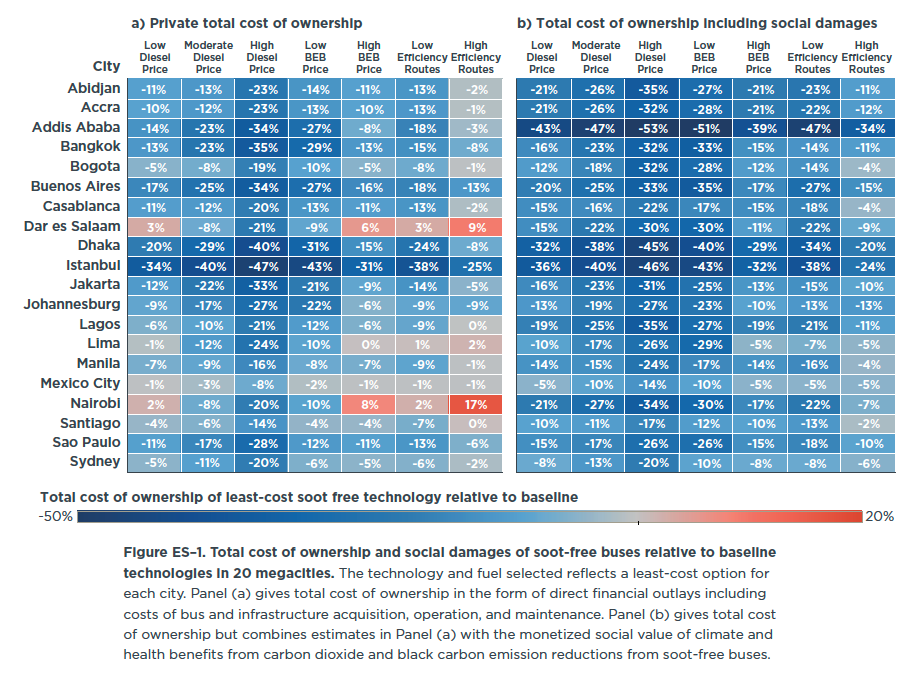Report
Financing the transition to soot-free urban bus fleets in 20 megacities
This report addresses the opportunities for facilitating, and the barriers to financing, the transition to soot-free urban bus fleets in 20 megacities. A soot-free engine is any diesel or alternative fuel engine that meets Euro VI or U.S. 2010 emission standards, such as any diesel engine with a diesel particulate filter, gas engine, or dedicated electric drive engine. These engines, in combination with ultralow-sulfur diesel (10 ppm sulfur or less) or alternative fuels, are capable of a 99% reduction in diesel black carbon emissions. The Climate & Clean Air Coalition (CCAC) launched the Soot-Free Urban Bus Fleets Project in 2015 to accelerate the deployment of soot-free engine technologies in 20 large cities around the world. This report provides the technical basis for city officials, local fleet operators, and financial institutions to jointly increase the finance of soot-free urban bus fleets in these cities.
Despite higher upfront cost, a transition to soot-free technology in these 20 cities over the next 10 years is associated with cumulative cost savings in the tens of billions of dollars. In these cities, soot-free urban bus fleets will on average deliver lower total cost of ownership, relative to the higher-polluting buses purchased today, within 5 to 9 years of purchase. These buses would require lower financial outlays over the life of the vehicle in most cities (17 of 20) and under most cases (including a wide range of diesel prices, capital costs, and bus operating efficiencies), despite a higher upfront cost. For example, a 10-year shift to soot-free technologies in all 20 cities assuming median diesel fuel prices would result in 3% to 40% lower total cost of ownership (see Figure ES-1). These cost savings are attributable to the lower operating costs of soot-free buses, which arise from using less (or less expensive) energy coupled with lower maintenance costs for certain technologies (i.e., diesel hybrids and dedicated electric drive). The monetized value of climate and health benefits adds to the savings and can justify investments in soot-free buses in all 20 cities, even under conservative assumptions.
National and local governments each have an important role to play in achieving soot-free bus performance. As demonstrated in the United States, the European Union, Canada, Japan, South Korea, and Turkey, national policies to improve fuel quality and implement Euro VI emissions standards can effectively ensure that all new vehicles demonstrate Euro VI performance. Yet local governments can also play a critical role in enabling or requiring a transition to soot-free performance. These actions can include adding minimum Euro VI emission requirements into procurement tenders and contracts; reforming local fuel and vehicle taxes that currently subsidize higher-polluting diesel fuels (containing more than 10 ppm sulfur) or vehicles; requiring public and private franchises to meet a minimum share of their in-use fleet with zero-emission buses; and adding retrofit or replacement requirements for new or existing franchises.
Beyond government policies and technology/cost factors, one of the most important findings is that new cleaner technologies with lower lifecycle costs require innovations in bus acquisition and financing in order to enable the transition to soot-free urban bus fleets. This begins with financing institutions, both domestic and international, taking a lifecycle cost of ownership perspective on their assistance programs. Direct assistance can include loan guarantees or concessional financing from climate finance institutions. Takeover clauses offered by public agencies can lower the credit risks to lenders and lessors of soot-free technologies, increasing access to public and private credit. Such guarantees can attract much larger volumes of co-financing from private banks and reduce the cost of borrowing by lowering risk premiums. Similarly, leasing strategies (notably battery leases) and service contracts over the full or partial lifetime of the vehicle can be structured to reduce the risks to operators and credit agencies of investing in new technology.

